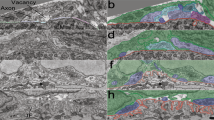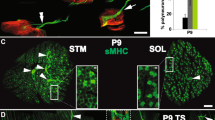Abstract
IN the search for the principles underlying the orderly development of the nervous system, it is interesting to know whether vertebrate neurones or muscle fibres can distinguish synaptic contacts of the axons which normally innervate them from the input of incorrect (or foreign) nerves. This possibility has been considered by asking whether foreign synapses induced on a denervated muscle fibre are displaced or suppressed when the muscle is reinnervated by its normal nerve. Observations of oculomotor reflexes in goldfish after experimental cross innervation of extraocular muscles led to the proposal that correct reinnervation suppressed foreign synapses1. Attempts to reproduce these results in the same system2, however, led to the opposite conclusion—that foreign transmission continued unabated after reinnervation by the correct nerve. A similar persistence of foreign synaptic function was found in reinnervated perch gill muscle3, frog fast muscle4, mammalian skeletal muscle5,6 and sympathetic ganglion cells7. Adult salamander muscle is the one other system in which suppression of incorrect synapses has been indicated; by the criterion of muscle fibre contraction monitored during foreign innervation and correct reinnervation, Cass et al.8 concluded that return of the correct nerve caused inactivation of foreign synaptic input. The present investigation examines this phenomenon at the level of transmitter release from individual synapses, and provides evidence that transmission by foreign nerve terminals declines in quantal content when adult newt muscle is reinnervated by its correct nerve.
This is a preview of subscription content, access via your institution
Access options
Subscribe to this journal
Receive 51 print issues and online access
$199.00 per year
only $3.90 per issue
Buy this article
- Purchase on Springer Link
- Instant access to full article PDF
Prices may be subject to local taxes which are calculated during checkout
Similar content being viewed by others
References
Marotte, L. R., and Mark, R. F., Brain Res., 19, 41–51 (1970); ibid., 46, 131–148 (1972).
Scott, S. A., Science, 189, 644–646 (1975).
Frank, E., and Jansen, J. K. S., J. Neurophysiol. (in the press).
Miledi, R., Nature, 199, 1191–1192 (1963).
Tonge, D. A., J. Physiol., Lond., 239, 96P (1974).
Frank, E., Jansen, J. K. S., Lomo, T., and Westgaard, R. H., J. Physiol., Lond., 247, 725–743 (1975).
Purves, D., Nature, 256, 589–590 (1975).
Cass, D. T., Sutton, T. J., and Mark, R. F., Nature, 243, 201–203 (1973).
delCastillo, J., and Katz, B., J. Physiol., Lond., 124, 560–573 (1954).
Lehouelleur, J., and Chatelain, A., J. Physiol., Paris, 68, 615–632 (1974).
Dennis, M. J., J. Physiol., Lond., 244, 683–702 (1975).
Author information
Authors and Affiliations
Rights and permissions
About this article
Cite this article
YIP, J., DENNIS, M. Suppression of transmission at foreign synapses in adult newt muscle involves reduction in quantal content. Nature 260, 350–352 (1976). https://doi.org/10.1038/260350a0
Received:
Accepted:
Issue Date:
DOI: https://doi.org/10.1038/260350a0
This article is cited by
Comments
By submitting a comment you agree to abide by our Terms and Community Guidelines. If you find something abusive or that does not comply with our terms or guidelines please flag it as inappropriate.



